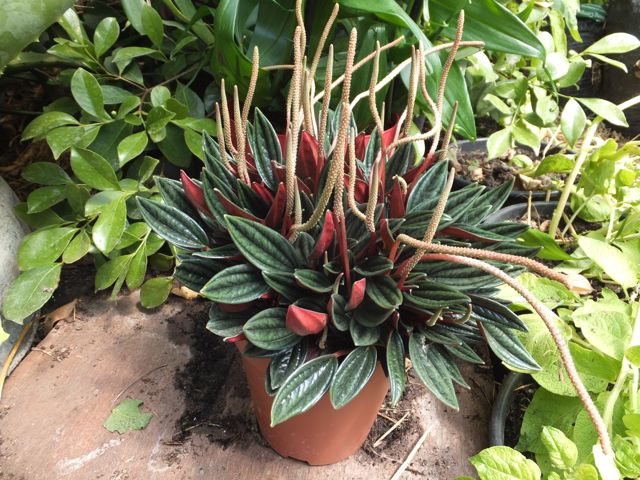 Once rare glasshouse specimens Peperomias are now common house-plants everywhere you go. Coming mainly from Mexico, the West Indies and South America these have not long been in cultivation most of them being discovered only from the mid nineteenth century. The great Paxton in his Botanical Dictionary of 1868 listed four dozen species and subspecies; This near doubled in a slightly more recent plant encyclopaedia, and lists of commercial cultivars and hybrids run to hundreds more.
Once rare glasshouse specimens Peperomias are now common house-plants everywhere you go. Coming mainly from Mexico, the West Indies and South America these have not long been in cultivation most of them being discovered only from the mid nineteenth century. The great Paxton in his Botanical Dictionary of 1868 listed four dozen species and subspecies; This near doubled in a slightly more recent plant encyclopaedia, and lists of commercial cultivars and hybrids run to hundreds more.
In this wave of similar but quite variable forms Peperomias have become incredibly popular as house and office plants. This is because they’re easy and cheap to multiply, and remarkably durable in the adverse conditions of our homes and buildings. Peperomias are herbaceous plants bordering on succulent. They thrive naturally in damp shade, cope with drier air and only really dislike bright sun. Indeed as many are compact, neat and slow growing, often making tight rosettes, these have always been popular for terrariums and bottle gardens. Others are trailing or creeping, though seldom invasive. As bonuses Peperomias seldom suffer the moulds bothering so many foliage plants and are not much liked either by the usual suspects such as snails and aphids.
Peperomia foliage may be heart to spear shaped with contrasting markings, geometrical variegation, with silvering, and in every variation of size and proportion. The choicest species and hybrids have the underside of their leaves and or their stems in white, green or wine red.
This tribe of tough tender plants were called Peperomias as the earliest species found much resembled the true pepper plant, Piper nigrum a close climbing relation hailing from Asia (and not Capsicum the hot and sweet peppers). One from Brazil, P. hederaefolia / griseo-argentea has shield shaped, quilted, silver painted leaves on pinkish petioles and has become known all over Europe as the Ivy peperomia. More bizarrely named are the popular P. sandersii, P. s. argyreia and hybrids which somehow became called the Watermelon Begonias. Another Brazilian the name is probably because the upperside of the spear shaped leaf is green while underneath is dark red making each them look somewhat like slices of watermelon, but Begonia….
Peperomias are seldom appreciated for their flowers, it’s just these are minute and assembled in their thousands into odd pipe-cleaner or snake like shoots which can be curiously attractive. However a few species such as P. resedaefolia have fluffy more flower like blooms.
Theoretically you could sow the microscopic seeds and grow the true species but choicer cultivars can be propagated more quickly and easily from stem cuttings, leaf cuttings and root division. They are not at all choosy about compost preferring a mix of leaf-mould and sandy loam, and of course warm rainwater when possible.










